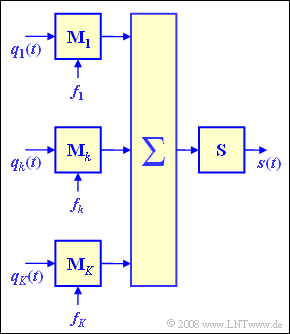Exercise 1.1Z: VHF II Broadcasting
From LNTwww
Electromagnetic waves in a frequency range from 30 to 300 MHz – corresponding to wavelengths between one and ten meters – are referred to as "ultra-short waves".
In common parlance, USW is also understood to mean the VHF II ("Very High Frequency") band, from 87.5 to 108 MHz, which is still primarily used in Central Europe today for transmitting frequency-modulated radio programs using analog technology.
The entire frequency band is divided into several channels, each with a channel spacing of 300 kHz.
The diagram displays the principle as a flow chart:
- A total of K signals qk(t) with different carrier frequencies f1, f2, ... , fk, ... , fK are modulated and added together.
- The summed signal is then beamed from a transmitter after power amplification.
- This outgoing signal is referred to as the transmission signal s(t).
Hints:
- This exercise belongs to the chapter Objectives of modulation and demodulation.
- Particular reference is made to the page Channel bundling – Frequency Division Multiplexing.
Questions
Solution
(1) Answer 1 is correct.
- FDM ("Frequency Division Multiplexing").
- The alternative multiplexing method, TDM ("Time Division Multiplexing") can only be implemented with a digital communications system.
(2) From the total bandwidth 20.5 MHz and the channel bandwidth 0.3 MHz we get K=68_.
(3) Answers 1 and 4 are correct:
- The channel spacing and thus the bandwidth 300 kHz available for a channel is significantly larger in the VHF range than for long, medium and short wave broadcasting. Although the frequency modulation used in FM broadcasting is characterized by better quality, it also requires more bandwidth.
- For comparison, in the medium wave range, amplitude modulation and a channel spacing of 9 kHz is always used (in Europe)
⇒ the source signal bandwidth is BLF=9 kHz/2 = 4.5 kHz. - The range of VHF is smaller than in the other frequency ranges because VHF radio waves are not reflected by the ionosphere. Therefore, a VHF transmission network usually consists of quite a large number of transmitters, which are set up at small distances from each other – and mostly at an elevation ⇒ answer 2 is incorrect.
- The signal arriving at the receiver has a much lower level than the transmission signal s(t), due to atmospheric attenuation, which increases at least quadratically with distance ⇒ answer 3 is incorrect.
- In a radio receiver, the tuner indeed has the task of channel separation ⇒ answer 4 is correct.
